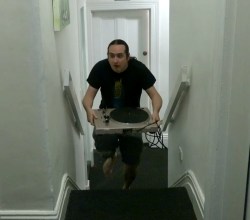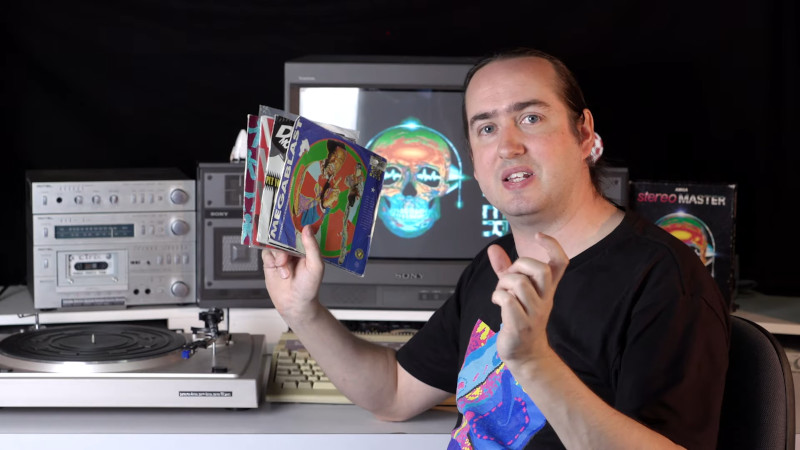Dance and house music exploded in a big way at the end of the 1980s. Typically the product of well-equipped studios with samplers and mixers worth thousands of dollars, it was difficult for the home gamer to get involved. That was, until the advent of the glorious Amiga, as [cTrix] ably demonstrates.

The video explains the history of both the music and the hardware, and highlights just why the Amiga was so special. Packing stereo audio and a four-channel sound chip, it had the grunt to pump out the tunes. All it was lacking was an audio input – which is where third-party hardware stepped in. Parallel-port analog-to-digital converters hit the market in a big way, letting users sample audio on their home computer without breaking the bank.
[cTrix] then proceeds to demonstrate how one would go about producing a dance track on an Amiga way back in 1990. A home stereo is used to play records, hooked up to a Stereo Master parallel port sampler. With a bunch of drum, piano, and synth samples recorded and saved on disk, a tracker is then used to assemble the track. It’s then compared with other music from the era as a great example of how things used to be done.
Overall, the Amiga will long have a legacy as the machine that brought real multimedia capabilities to the home computer. It’s one of our favourites, though keeping them going can be tough sometimes. Video after the break.















>”real multimedia capabilities”
Almost. The Amiga or the trackers couldn’t actually produce very high quality for music production because of the limitations of the hardware and memory for sample size/resolution, and the characteristic hackyness of the tracker style of playback: no filters, fake echoes, quantization, and 8-bit “bends”… It was a complete toy and a gimmick until you added MIDI output to proper synths or pump the sounds through a whole bunch of effects/filters which were not available back in the day.
Even by 90’s techno-pop standards, the Amica tracker scene was like the Fisher-Price of music. Only a handful of people ever made it sound good enough to put on real production.
Found the Atari ST owner!
I actually laughed out loud :) +1
Hello, is this nine-one-one? I’d like to report that shots has been fired.
Pass the popcorn…..
That’s the point though. None of the home computers of that era were actually good enough to make music.
An Atari ST would be useless without racks full of other equipment. So was the Amiga – but the Amiga owners were incredibly smug because they could -almost- make real music with just the computer alone – so a horde of wannabe music geeks made a ton of terrible techno because that’s all you could really pull off with it.
The tracker was a sort of in-between thing from FM chips to real software synthesis. Playing little soundbites really fast to fake it was just like the HAM video mode to display high color graphics. The point of the whole Amiga computer was to pull off such gimmicks in order to pretend that the hardware was ahead of its time when in reality it was a dying dinosaur of a bygone era.
Apparently you are not a musician, otherwise you’d understand that it’s not the instrument that makes the music, it’s the performer. What do you think the quality of instruments and gear is for the average band especially back in the late 80’s early 90’s? It’s never studio grade, but somehow breakthrough albums and singles often have either low-fi origins or are a mastered version from the original recording.
The Dutch house and German rave scene produced oodles of records pulled straight of A500 or A1200 for years.
The Amiga was the cheap guitar, but I can get real music out of a cheap guitar while in most likelihood you could not get anything out of a 3k$ Godin.
From a purely hardware perspective, you may have a bit of a point, but that really is irrelevant at the point where an Amiga with tracker software becomes the instrument. Just like retro-chip tunes. Would you dis that music because the chips are ancient? That would be stupid.
Polish hiphop started on Amigas. Seminal 1996 Kaliber 44 album was created on Amiga 500 (and some unspecified 16bit sampler):
https://www.youtube.com/watch?v=2rePrmu3R9w
100K copies sold
Right.
I knew that I heard this in that documentary about the TB-303, someone once said something like “the limits of the device and the PITA of getting it to do what you wanted were likely significant positively-contributing factors in the artistic process” or something like that. So I looked it up, the documentary is called Bassline Baseline (need to watch it again now) and the quote is right at the beginning on a title card:
“Since so much of our experience is mediated in some way or another, we have deep sensitivities to the signatures of different media. Artists play with these sensitivities, digesting the new and shifting the old. In the end, the characteristic forms of a tool’s or medium’s distortion, of its weakness and limitations, become sources of emotional meaning and intimacy.” –Brian Eno
Funny, I should’ve remembered that name. Anyway it was taken from this article: https://www.wired.com/1999/01/eno/
I have heard much better music on my Amiga 500 in 1989 than i hear nowadays in the radio.
That “Terrible Techno” was much better than the desert of Autotune that is modern mainstream music in my opinion.
As an Amiga fan, I don’t like to promote ‘the enemy’, but I have to admit that the Atari ST was used more professionally.
Here’s an interesting video showing Norman Cook (aka Fatboy Slim), showing off his original ST, sampler and synth collection where he created some of early tunes. He still has them backed up on 3.5″ disc.
[youtube https://www.youtube.com/watch?v=qLjgXPDzeZo&w=560&h=315%5D
cTrix is an incredible musician and thanks for sharing this vid! One of my favorite songs by him is “Human Nature”, this gem for Amiga 500 that won a compo in 2010:
https://www.youtube.com/watch?v=O_HZas8eqQE
yeah, i really enjoyed that video. Over that time period, I was more aware of the pro side of the hardware… Macs and samplers basically, and in the mid 90s I coughed up nearly a grand for a Turtle Beach Monterey 16 bit card set for my PC. I had heard about Amigas and the tracking scene, but not really in detail, so this was quite interesting to see it discussed in depth.
I think the key thing to remember is that tracking “democratized” electronic music creation at a time when the mainstream stuff was so expensive. As mentioned, a lot of artists had their start with this gear, where they learned a ton of tricks and developed a vocabulary that was transferable to better equipment and software.
and I totally dug the Nagra t-shirt he was wearing. I want one bad.
I found this very amusing, so I showed it to my kids and pointed out that they have no idea how easy they have it these days. Makes you wonder exactly how much you could do on an ESP32 with a few extra components.